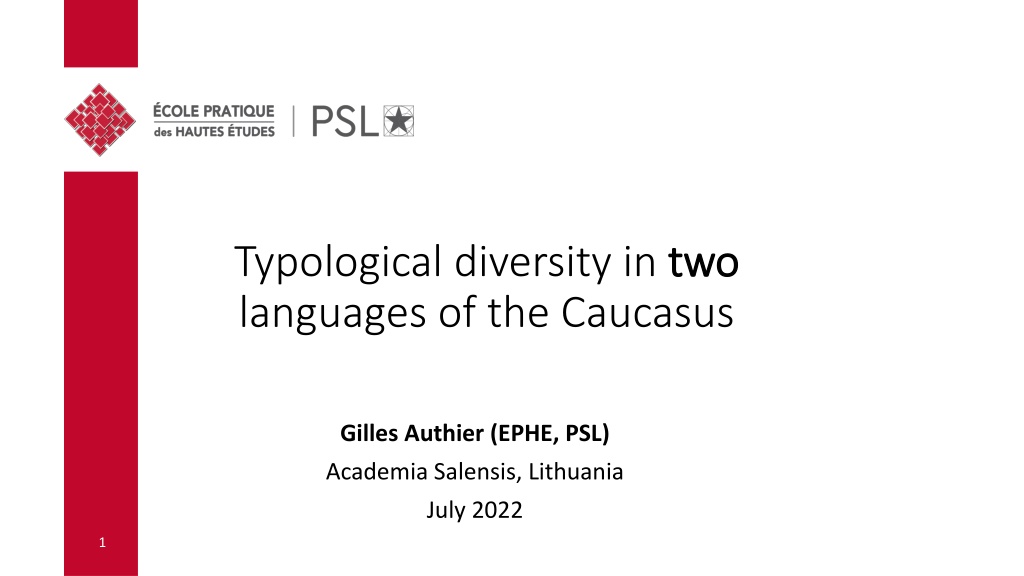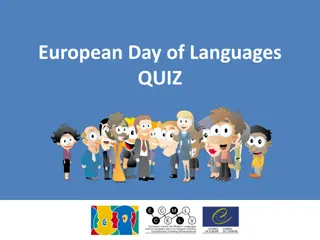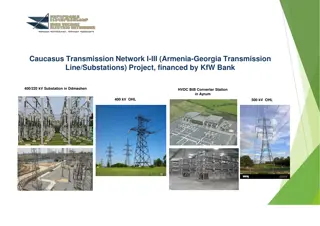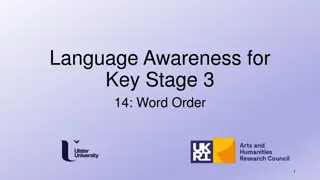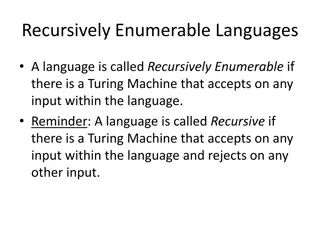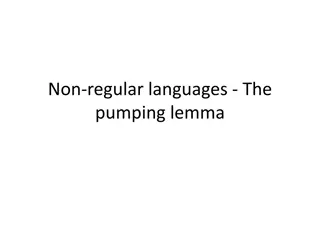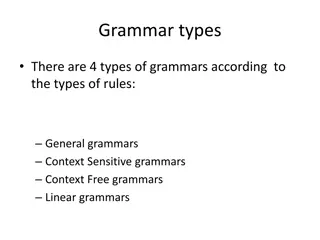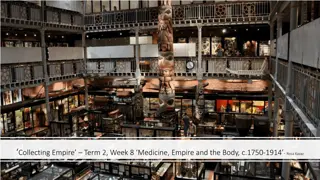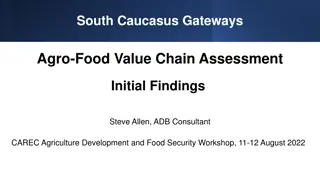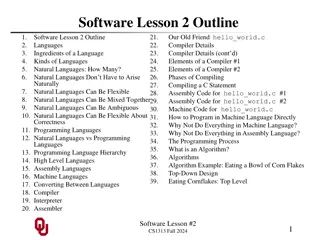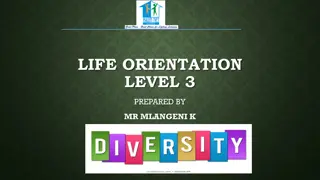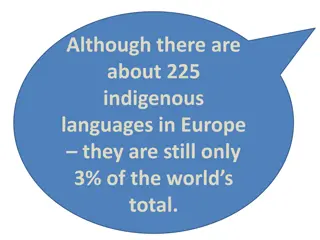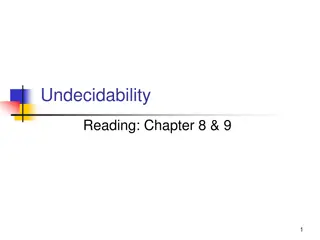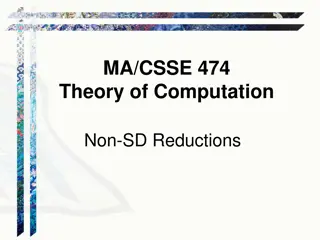Typological Diversity in Azeri and East Caucasian Languages of the Caucasus
Examining the typological diversity in Azeri and East Caucasian languages of the Caucasus, this study by Gilles Authier focuses on the mutual unintelligibility of 30-40 East Caucasian languages, classified into 7-8 subgroups like Nakh, Avar, Lak, Budugh, and Lezgic. The research sheds light on the linguistic richness and complexity of these languages, offering valuable insights into the region's linguistic landscape.
Download Presentation

Please find below an Image/Link to download the presentation.
The content on the website is provided AS IS for your information and personal use only. It may not be sold, licensed, or shared on other websites without obtaining consent from the author. Download presentation by click this link. If you encounter any issues during the download, it is possible that the publisher has removed the file from their server.
E N D
Presentation Transcript
Typological diversity in two languages of the Caucasus two Gilles Authier (EPHE, PSL) Academia Salensis, Lithuania July 2022 1
Azeri 2
East Caucasian East Caucasian 30-40 (mutually unintelligible) languages 7-8 well-accepted subgroups Nakh Avar Lak Budugh Lezgic K 3
AZERI Bir g n Molla f rsiz bir b rb rin lin d r. B rb r ba n m xt lif yerl rd n q rx b, z rin pamb q y n yap d r b. Molla bird n g zg d z n bax r, pamb n ba na yap d n g r r. O, aya a qalx b papa n ba na tax b qa r. B rb r ona deyir: Molla, hara gedirs n? M n s nin ba n n dig r yar s n h l q rxmam am! Molla deyir: "M n b t n ba mapamb q km kfikrind deyil m!" Bu qalan yar ya yun k c y m. 4
BUDUGH ma'lla' sad d sar xam dallakca xaba' araxhari. dallakc r una' q' l uq'cu c ga'car t' pombu rk r . ma'lla'c r sad y pa aynecuxun ir ari ; uga' q'ala' k r pombu rqh r . illa' ada' uzurnu uga' q'emel i ni uga' q'ala' uxhon rixa' araxhari. dallakc r yu uri : ma'lla' v n heyen a ara'vi ? z n hala va' q'ala' ya'ru oroxodab ! ma'lla'c r yu uri : za' q'ala' ba' p t pombu d r ra' ki ! ulu ipkini ya'ruye z n yiz er ira'. 5
AZERI 20 20 consonants = [ ] c = [ ], = [ ] Uvulars x: m xt lif, bax r, tax b [q:] : y n , pamb q, pamb n, pamb a yap d n , aya a, papa n , qalx b, qa r, q rxmam am, qalan Glottal(s) h: hara 6
BUDUGH 30 30 consonants Ejectives t' , q' l, q'emel i, uq'cu + p , ts , , k Uvulars rixa , xam, xab, oroxodab d rqh r [q:] : illa , uzur-nu, rk -r Velars araxhari, uxhon Pharyngeals ayne-cuxun; araxhar-i; ada , d r ra , er ira ir ar-i glottals heyen; yu u-ri 7
BUDUGH 30 dental d 30 consonants palatal velar c = [ ] g labial b uvular pharyngeal glottal [q:] qh voiced voiceless (aspirated) ejective p t = [ ] k h p f v m t ts k q = [ ] ( ) n y, r, l 8
AZERI and BUDUGH vowels Azeri Budugh ( / ) o (e) a o e a i, , u i, , u /a/ => [a] [ ] after back consonants, + LOC -a , + Azeri loans with /a/ elsewhere 9
AZERI syllabic structure V o, -li-n , -z -ri-n VC l, z CV ba- -n CVC bir, g n, d - r, RC q rx- b, pamb q, qalx b yer-l r-d n, bir-d n, ged-ir-s n, CC m xt lif yap- -d r- b, g z-g -d , k-m k q rx-ma-m -am 10
BUDUGH phonotactics (C)V : xaba' ( )araxhari RC, CC: q'emel i ba' -p t (Az. ba -b t n) illa dallak-ca, uq -cu i-p-kini -r-k r , i-r- ari, -r-qh r , d -r- ra , e-r- ira 11
AZERI: declension NOMba l yun g n Molla o ACC GEN DAT LOC ABL ba - ba - n ba -a ba -da ba -dan l-i l-in yun-un l- yun-a l-d yun-da l-d n yun-dan yun-u g n- g n- n g n- g n-d g n-d n Molla-y- Molla-n- n Molla-y-a Molla-da Molla-dan o-n-u o-n-un o-n-a o-n-da o-n-dan 12
AZERI NPs Head-final / Left-branching f rsiz bir clumsy one barber-GEN hand-POS3 b rb r-in l-i indefinite article = one : bir g n DOM (Differential Object Marking) yun / yun-u wool wool-ACC sow-FUT-1 I ll sow wool / the wool. k- c y- m. 13
AZERI possessive NPs GEN/POSS bir b rb r-in l-i; the hand of a barber s n-in ba - -n n yar -s half of your head Nominalizations pamb - n ba - -na cotton-GEN head-POS3-DAT He sees that cotton has been stuck on his head. yap -d - -n stick-NMLZ-POS3-ACC g r- r. see-PRS 14
AZERI case morphology Bir g n Molla f rsiz bir b rb r-in l-i-n d r. B rb r ba - -n m xt lif yer-l r-d n q rx b, z r-i-n pamb q y - -n yap d r b. Molla bird n g zg -d z- -n bax r, pamb - n ba - -na yap d - -n g r r. O, aya -a qalx b papa - -n ba - -na tax b qa r. B rb r o-na deyir: Molla, hara gedirs n? M n s n-in ba - n- n dig r yar -s -n h l q rxmam am! Molla deyir: "M n b t n ba - m-apamb q km k fikr-i-nd deyil m!" Bu qalan yar -ya yun k c y m. 15
AZERI possessive NPs bir b rb r-in l-i-n d r. into the hand(s) ofa barber ba - -n q rx- b... having shaved his head pamb - n ba - -na yap d - -n g r r. sees that cotton is stuck on his head papa - -n ba - -na tax b... having put his hat on s n-in ba - n- n yar -s -n q rxmam am! I have not shaved half of your head ba - m- pamb -a km k fikr-i-nd deyil m I don t mean to sow my head in cotton z r-i-n on it 16
AZERI possessive NPs, 2: position nouns (o-nun) (m n-im) (s n-in) z r-i-n z r-im- z r-in- on it on me on you, sg z r-im-d alt- m-da on me under me qar - m-da dal- m-da in front of me behind me (biz-im) (siz-in) (on-lar- n) z r-imiz- on us z r-iniz- z r-l r-i-n on them on you, pl yan- m-da i -im-d near me in me z r-im-d z r-im-d -n on me (no mvt) from on me + z- -n bax r looks at himself < at his marrow 17
BUDUGH cases (15) BUDUGH NPs Head-final / Left-branching sar xam one-M clumsy barber-LOC dallak-ca xab hand NOM xab z n ERG xab-c -r z n indefinite article = one : sa-dd DAT xab-c -z zaz GEN xab-cu zo LOC xab-ca za Gender agreement on numerals sa-r dallak M sa-r hec F sa-bq l A sa-dd N ABL xab-ca-r za r APUD xab-cux zox DIR xab-cuxun zoxun PART xab-cik zak 18
BUDUGH possessive NPs, 2: position nouns illa' leg.LOC on (his) leg(s) ada' surface.LOC za za ada' q an-ik on me under me za uran za xa gal-ca behind me in front of me illa' leg.LOC on (his) leg(s) q an-ik bottom-PART<SUB za za yan-ca ara near me in me 19
BUDUGH possessive NPs sar dallak-c-a xab-a into the hand(s) ofa barber u-n-a' q' l t' ... having cut his head ug-a' q'al-a' k r pombu the potton stuck on his head ug-a' q'emel i ni ug-a' q'al-a' uxhon having put his hat on his head v-a' q'al-a' ya'ru oroxodab ! have not shaved half ofyour head z-a' q'al-a' pombu d r ra' ki ! will not sow cotton on my head 20
Differential Differential possessor possessor marking marking ((in)alienability) Budugh replaced the highly allomorphic genitive still found in Kryz by two originally spatial cases: 1) the locative (originally inessive) in -a Ma lla -ca / za q l, Ma lla -ca / my head za xab my hand 2) the new genitive (originally adessive) in -u/o Ma lla -cu / zo yiz, my wool Ma lla -cu / zo dallak my barber Note the split across kinship terms: Ma lla -cu / zo my see Authier (2013) for a detailed account. ri daughter / Ma lla -ca / za dix son my 21
BUDUGH NPs, problems sa-d d one-N day sa-d y pa having said one > suddenly sa-r xam dallak-ca one-M clumsy barber-OBL.LOC instead of suncu one.OBL xab-a' hand-LOC language attrition? 22
AZERI verbal morphology 2 - NOMINALIZATIONS Infinitive: -mAQ k-m k fikr-i-nd ; g r-m k/ qal-maq, (ol-maq be ) Sequential converb (=PERF(3)): -(y)Ib qalx- b, tax- b / k-ib / g r- b / ol-ub Active participle: -(y)An qal-an yar / k- n / g r- n / / ol-an Non active participle / nominalizer: -dIQ- yap -d - -n / k-diy-i-ni / g r-d y- -n / ol-du -u-nu 25
AZERI TAM INFLECTION: the present tense PRS: -(y)Ir PRS: PRS: -(y)Ir d -m k end_up de-m k say d - r- m d - r-s n d - r d - r- k d - r-s z d - r-l r qa -maq run ol-maq be qa - r-am qa - r-san qa - r qa - r- q qa - r-s z qa - r-lar de-yir 26
AZERI TAM INFLECTION: the future tense FUT FUT k-m k sow g r- see bax-maq look ol- be k- c y- m k- c k-s n k- c k k- c y-ik k- c k-siz k- c k-l r bax-aca -am bax-acaq-san bax-acaq bax-aca - q bax-acaq-s z bax-acaq-lar 27
AZERI TAM INFLECTION: the eventual tense PRS: -(y)Ir PRS: PRS: -(y)Ir d -m k end_up de-m k say d - r- m d - r-s n d - r d - r-ik d - r-siz d - r-l r qa -maq run ol-maq be qa -ar-am qa -ar-san qa -ar qa -ar- q qa -ar-s z qa -ar-lar de-y r 28
AZERI TAM INFLECTION: the unwitnessed past UWPST Negative UWPST g r-m k see g r-m - m g r-m -s n / g r- b-s n g r- b g r-m - k g r-m -s z g r-m -l r de- say q rx-maq shave ol- q rx-ma-m -am q rx-ma-m -san q rx-ma-y b q rx-ma-m - q q rx-ma-m -s z q rx-ma-m -lar be 29
AZERI TAM INFLECTION: the witnessed past (slightly different personal endings) WPST: -dI- WPST: -dI- de-m k say g r- see bax-maq look ol- be de-di de-di-n de-di de-di-k de-di-niz de-di-l r bax-d -m bax-d -n bax-d bax-d -q bax-d -n z bax-d -lar 30
BUDUGH ma'lla' sad d sar xam dallakca xaba' araxhari. dallakc r una' q' l uq'cu c ga'car t' pombu rk r . ma'lla'c r sad y pa aynecuxun ir ari ; uga' q'ala' k r pombu rqh r . illa' ada' uzurnu uga' q'emel i ni uga' q'ala' uxhon rixa' araxhari. dallakc r yu uri : ma'lla' v n heyen a ara'vi ? z n hala va' q'ala' ya'ru oroxodab ! ma'lla'c r yu uri : za' q'ala' ba' p t pombu d r ra' ki ! ulu ipkini ya'ruye z n yiz er ira'. 31
BUDUGH deictic deictic verbal derivation a-raxhar-i > fall IN -t' (e-t e) > cut IN a-raxhar-i > run (DOWN) -r-k -r ( i-r-ki-ri), u-zur-nu, u-xho-n ( -xha-n ) > stick ON -d -r- -ra , e-r- i-ra > push OUT > grow, sow ALL Budugh verbs are bipartite 32
BUDUGH deictic verbal derivation, 2 i-r-ki a-r-ki - - - ve-r-ki to stick on to stain a-ra-xh-ar to run a-ra-xh-ar to fall a-ra-xh-ar to open, itr a-ra-xh-ar to run under va-ra-xh-ar to strike (illness) ya-ra-xh-ar to dissipate (fog) to touch 33
zn 1SG araxhar-i M/F.end_up.IPF-PRS / oroxhor-i. A.end_up.IPF-PRS I end up v n 2SG araxhar-i M/F.end_up.IPF-PRS / oroxhor-i. A.end_up.IPF-PRS You(sg) end up a-d a-d- r ararxhar-i. a-d oroxhor-i. araxhar-i. He ends up She ends up She ends up yin 1PL a-ba-rxhar-i. HPL.end_up.IPF-PRS We end up vin 2PL a-ba-rxhar-i. HPL.end_up.IPF-PRS You(pl) end up a-cber DIST-PL.NOM a-ba-rxhar-i. HPL.end_up.IPF-PRS They end up 34
Budugh Gender/Number INFLECTION end up IPF end up PF a-r-xhu a-r-xhu a-p-ku M F A N HPL a-ba-raxhar NHPL araxhar araxhar araxhar oroxhor araxhar M F A *a-v-raxhar N HPL NHPL a-t-ku a-ba-r-xha a-ra-xha 35
Budugh Gender/Number INFLECTION run IPF run PF a-r-xhu a-r-xhu a-p-ku a-t-ku a-ba-r-xha a-ra-xha M F A N HPL a-ba-raxhar NHPL araxhar araxhar ara-xhar oroxhor araxhar M F A N HPL NHPL 36
Budugh Gender/Number INFLECTION remain IPF -n-kan -n-kan unkon -n-kan -ba-n-kan remain PF i-r-ki-n i-r-ki-n i-p-ki-n i-t-ki-n i-p-ki-n M F A N HPL M F A N HPL 37
Budugh Gender/Number INFLECTION go IPF a- ar a-r- ar o or a- ar a-b- ar go PF vi-xhi vi-r-xhi v xh vi-t-ki vi-p-ki M F A N/NHPL HPL M F A N/NHPL HPL 38
AZERI valencies transitive : NOM + ACC papa - -n cap-POS3-ACC head-POS3-DAT put-PERF intransitive : NOM (+ LOC) Molla l-i-n (NOM) hand-POS3-DAT ged-ir-s n go-PRS-2SG aya -a qalx- b foot-DAT stand_up-SEQ run-PRS(3) ba - -na tax- b d - r. fall-PRS(3) ba - m- head-POS1-ACC cotton-DAT sow-INF pamb -a k-m k qa - r. BUT extended intransitive : NOM + DAT Molla z- -n (NOM) self-POS3-DAT look-PRS(3) yun wool sow-FUT-1SG k- c y- m bax- r 39
Budugh valencies, 1 NOM (+LOC) ma'lla' NOM(M) xab-a' hand-LOC araxhar-i. M.end_up-PRS ma'lla' NOM(M) rix-a' road-LOC araxhar-i. M.run-PRS v n 1SG(M) heyen whereto a ar-a'vi ? M.go.IPF-PROG 40
Budugh valencies, 2 ERG + NOM (triggers gender/number agreement) dallak-c r u-n-a' barber-ERG PROX-H-LOC head(A) q' l t' A.cut.PF(SEQ) cotton(A) pombu rk r . A.stick.PRS z n 1SG ya'ru oroxo-da-b. half save.PF-NEG-A (Molla-c r) ERG ug-a' q'emel i self-LOC cap(A) ni ADD ug-a' q'ala' self-LOC head.LOC uxho-n (...) A.put_on.PF(SEQ)-ADD z n 1SG za' 1SG.LOC q'ala' head.LOC pombu cotton(A) d r -ra' A.NEG.plant.IPF-FUT EXCL ki ! z n 1SG yiz wool(N) er ira'. N.plant.IPF-FUT 41
Budugh valencies, 3 ERG(+LOC) ma'lla -c r ERG ayne-cuxun ir ar-i mirror-DIR look.IPF-PRS Affective / Perception verbs: DAT experiencer + NOM stimulus (ma'lla -c z) M-DAT pombu cotton(A) rqh -r . (A)see.IPF-PRS (ma'lla -c z) M-DAT yiz wool(N) irqhi-ri. (N)see.IPF-PRS 42
BUDUGH TAM inflection, synthetic tenses GPRS: araxhar-i, ir ar-i, araxhari, yu u-ri / rk r- , rqh -r FUT er i-ra > IMPERF: araxhar-ni, rk r-n , etc IRREAL: ( er i-ra -ni) PROG a ar-a'vi PROG.PST: ( a ar-a'vni) AOR: (oroxo-ci) AOR.PST (oroxo-cni) 43
BUDUGH verbal nega negation tion, , suffixed suffixed GPRS: araxhar-i NEG: (araxhar-da-r) PROG a ar-a -vi NEG: ( a ar-a -da-r) AOR: (oroxo-ci) NEG: oroxo-da-b 44
BUDUGH verbal negation, , prefixed prefixed FUT ( -r -ra ) NEGFUT: -d -r -ra = negated non finite forms IPFPTCP/MSD: araxhar NEG: a-da-raxhar PFPTCP/INF: oroxo NEG: o-do-roxo 45
AZERI clause combining (subordination) Clause chaining B rb r ba - -n m xt lif yer-l r-d n q rx- b, z r-i-n pamb q yap d r- b. shave-SEQ stick-PERF(3) O, DIST [ aya -a foot-DAT qa - r. run-PRS(3) qalx- b, stand-SEQ papa - -n cap-POS3-ACC head-POS3-DAT ba - -na tax- b] attach-SEQ 46
AZERI clause combining (subordination) Relative clauses qal-an remain-ing yar half Complementation pamb - n cotton-GEN ba - -na head-POS3-DAT yap -d - -n stick-NMLZ-POS3-ACC g r- r. see-PRS(3) He sees that cotton has been stuck on his head. 47
BUDUGH clause combining Relative clauses [ug-a' REFL3-LOC q'al-a' head.OBL-LOC A.stick.PF-PTCP k r- ] pombu cotton(A) rqh -r . A.IPF.see-PRS Clause chaining dallak-c r barber-OBL.ERG [u-n-a' PROX-OBL.H-LOC q' l head(A) uq -cu some-OBL c ga -car place-OBL.EL A.cut.PF(SEQ) t' ] pombu cotton(A) rk -r . A.IPF.stick-PRS 48
Setting the problems Probably all languages have means to express the difference between - an action viewed as a whole / completed : perfective - and the same action viewed as ongoing / incomplete: imperfective - and much is understood now about the grammaticalization of aspect. But - - not all, maybe not a majority of languages mark this difference on the lexical verb many languages with verbal aspect marking combine it with other categories, like voice languages with aspect marking on the verb often have non-binarysystems secondary aspectual categories (often linked with modality or evidentiality) blur the picture crosslinguistically, reduplication seems to be iconic of IPF aspect but not proper grammar - - - 50
